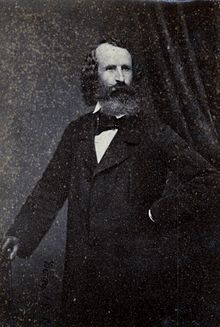William Page (painter)
William Page | |
|---|---|
 | |
| Born | January 3, 1811 |
| Died | October 1, 1885(aged 74) Tottenville, Staten Island,New York, US |
| Signature | |
 | |
William Page(January 3, 1811 – October 1, 1885) was an American painter and portrait artist.
Biography
[edit]
He came to New York City with his parents at the age of nine, and in 1822 received a premium from theAmerican Institutefor a drawing inIndia ink.At the age of 14, he began to study law in the office ofFrederick de Peyster,which he soon left to enter the studio ofJames Herring,and in less than a year he became a pupil ofSamuel F. B. Morse,through whom he also enrolled at theNational Academy of Design.[1]His drawings in the antique class at the National Academy won him the silver medal, but, having joined thePresbyterian Church,he determined to enter its ministry. For two years from 1828, he studied theology at theAndover Theological SeminarandAmherst College,at the end of which time he returned to art.[2][1]
After painting portraits in Albany for a year, he went to New York, where he executed likenesses ofWilliam L. MarcyandJohn Quincy Adams.In 1836, he was elected a National Academician, and he was president of the National Academy from 1871 until 1873.[1]About 1844 he moved toBoston,but in 1847 he returned to New York for a stay of two years.[2]
Page then went to Italy, where he resided for eleven years inFlorenceandRome,coming back toNew Yorkin 1860. While he was in Italy, he painted the portraits ofRobertandElizabeth Browningand other well-known Englishmen and Americans. He also took occasion to study the works of the great masters, notablyTitian,whom he admired and emulated, and whose method of painting he strove to discover. The copies that he executed of Titian's paintings were so remarkable that one of them was seized by the Florentine authorities under the belief that it was the original.[2] He was also a friend ofWilliam Wetmore Storyand ofJames Russell Lowell,who dedicated his first collection of poems to him in 1843.
He died in 1885, aged 74 onStaten Island. Although extravagantly praised as an artist from the 1830s into the 1860s, Page's reputation suffered in later life because he changed his style so frequently and, more particularly, because technical characteristics of his painting method soon caused much of his work to darken excessively.
Works
[edit]
In Italy, he produced his "Venus," "Moses and Aaron on Mount Horeb," "Infant Bacchus," and "Flight into Egypt." His work also includes a full-length portrait of AdmiralDavid Farragutat theBattle of Mobile Bay(purchased by a committee in 1871, and presented to the emperor of Russia), the "Holy Family" (1837, now at theBoston Athenaeum) and "The Young Merchants" (now atPennsylvania Academy of the Fine ArtsinPhiladelphia).[1]In 1870, Page exhibited a portrait head ofJesus Christwhich attracted great attention and excited much controversy. Other paintings include: "The Last Interview" (1838), "Ruth and Naomi," and "Cupid" (1880).[2]
Among his many portraits, for which he was most noted, are those ofHiram Powers(painted in Florence about 1848),Henry Ward Beecher,Wendell Phillips,Charles P. Daly(1848, inNew York Historical Society),James Russell Lowell,Josiah Quincy III,Gov.Reuben E. Fenton(1870),Charlotte Cushman,Ulysses S. Grant(1880),Thomas Le Clear(1883), andCharles Sumner(left unfinished upon Sumner's death). In 1874 Page made a second visit to Europe, in order to studyLudwig Becker'ssupposed death mask ofWilliam Shakespearepreserved in Germany, and on his return he executed a large bust and several portraits of Shakespeare (1874–78).[2]
He wroteA New Geometrical Method of Measuring the Human Figure(1860), and invented and patented various improvements in boats and guns.[2]
Notes
[edit]Attribution
- This article incorporates text from a publication now in thepublic domain:Wilson, J. G.;Fiske, J.,eds. (1900)..Appletons' Cyclopædia of American Biography.New York: D. Appleton.
References
[edit]- Chisholm, Hugh,ed. (1911)..Encyclopædia Britannica.Vol. 20 (11th ed.). Cambridge University Press. p. 450.
- "Smithsonian Institution: Collections Search Center: Josiah Quincy".Retrieved27 January2012.
